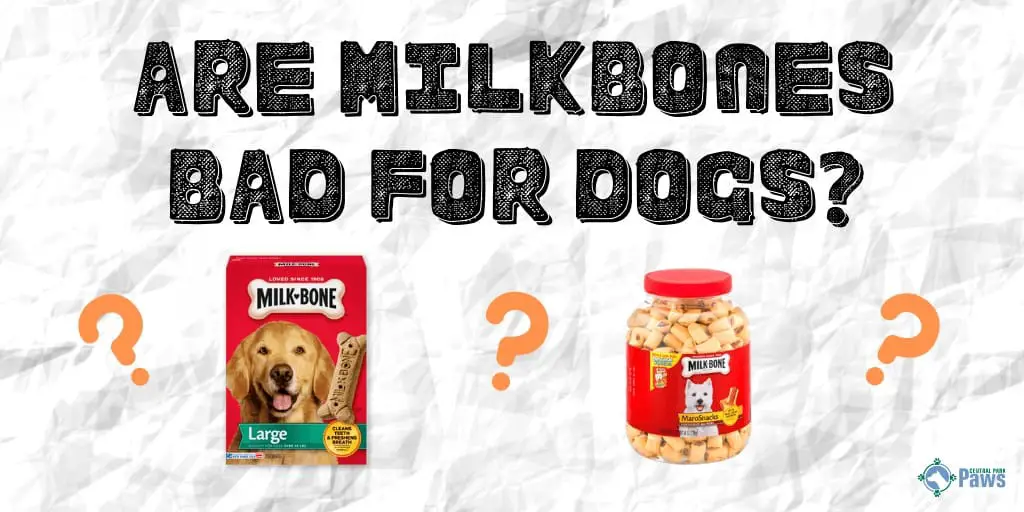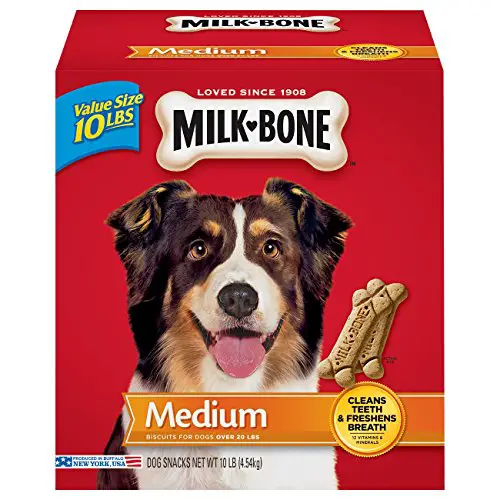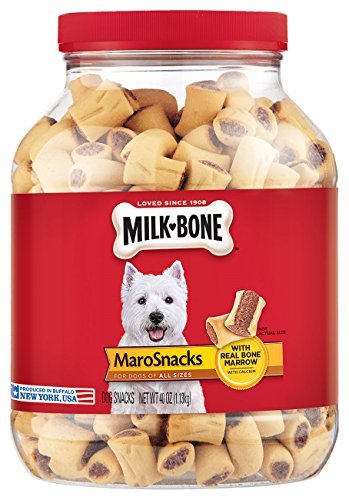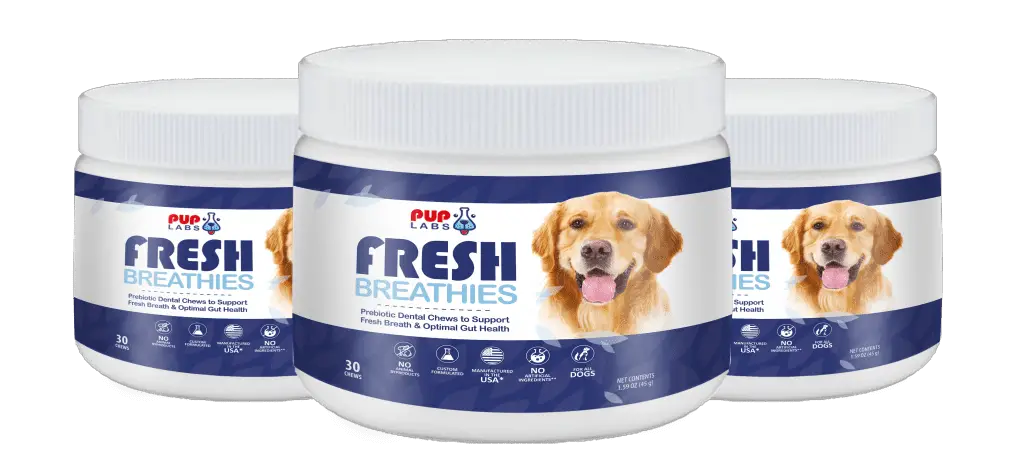Most of what I was told was advice I put into action, like taking care of her dental health and getting her ears cleaned at every visit to the groomer’s.
Many people also warned me about the different things I could feed her. I was told to stick with things that were all-natural, grain-free, and made without allergens.
This surprised me, because none of the dogs my family grew up with had any of those things.
They got whatever treats they liked and that was that.
I had never looked into things like treats, but I was warned about Milk-bones.
The same Milk-Bones my family’s dogs had eaten for years.
What was so bad about them?
Here’s what I learned and why it changed my mind.
Related: Are Dog Bones Safe for Dogs?
What are Milk-Bones?
Even if you’ve never bought Milk-Bones before, you’ve definitely seen them.
They’re the bone shaped dog biscuit treat that used to be in nearly every household, groomer shop, and vet clinic.
They can come in different flavors, so they’re all different colors, but the traditional one is tan and easy to break apart for easy chewing[1].
Depending on which type of Milk-Bone you get, they’re meant for different purposes.
The traditional Milk-Bones are supposed to be used for a reward for good behavior.
Other products under the Milk-Bone brand are made to improve the oral health of dogs, much like Dentastix.
What Are Milk-Bones Made Out of?
What each Milk-Bone is made out of will differ depending on which flavor you’re looking at.
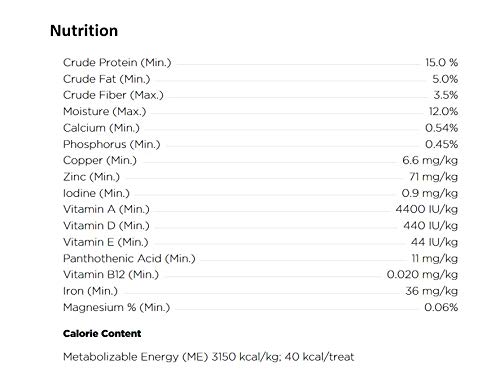
The traditional flavor includes ingredients like:
- Whole wheat
- Meat and bone meal
- Milk
- Beef fat
- Minerals
Because of the wheat and milk, the calorie count for the large milk bones comes to 125 calories per treat, which may be a bit higher than what you’re used to giving your dog.
It’s something to be aware of as you check ingredients and weigh them against what you want to feed your pup.
Related: Safe Bone Alternatives: Yak Chews, Fish Skin, Etc
Are They Bad for Dogs?
This part was what really tripped me up.
If Milk-Bones were such a classic treat, why was everyone telling me not to give them to Maggie?
It all comes down to BHA.

Source: Wikipedia
BHA is a food additive that helps preserve food and bulk up the food that’s produced, essentially making more of a product for less money and making it last longer[2].
While the Food and Drug Administration has said that BHA can be consumed safely[3], the National Institutes of Health have deemed it a carcinogen for both humans and animals[4].
Essentially, this means that your dog can eat products that have small amounts of BHA in it, but over time, this could increase their risk of developing cancer.
Milk-Bones responded to this claim back in 2016 when a Facebook video went viral about the BHA in Milk-Bones[5].
The company said that the small amounts of BHA preserves the treats and protects against bacteria growth, and that it’s completely harmless[6].
Are Milk-Bones Good for Dogs?
There are different types of Milk-Bones which all have a different purpose.
The traditional treats are just meant to be treats, so if you’re trying to keep your dog on a low-carb diet, feeding them to your dog frequently won’t be good for them.
There are also products like the GnawBones and Brushing Chews that are meant to improve your dog’s dental health.
These have received the VOHC’s Seal of Approval for tartar control, so they’ve been proven to be good for dogs in that regard[7].
Healthy Milk-Bone Alternatives
While there are currently no studies that have taken Milk-Bones off the shelf for being bad for dogs, you may feel uncomfortable feeding them to your dog if the BHA levels concern you.
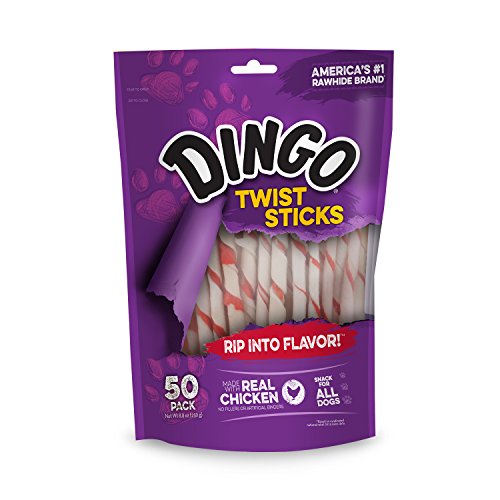
- Frozen whole carrots
- Rawhide chews
- Beef bones (Artificial bones like Nylabones are not the same)
The main benefit to Milk-Bones is that most of their products are advertised as being good for the dental health of dogs. Any of these treat alternatives will help with that as well.
Anything that your dog can chew on for an extended period of time will work around their teeth and knock plaque away[8].
Chewing also increases their saliva production, which washes out bacteria that could cause gum disease[9].
Conclusion
I’ve personally seen dogs eat Milk-Bones for treats over a period of years and they never had any health issues because of them.
I would be fine if Maggie had a Milk-Bone every now and then, but since I have her on all-natural treats currently, I don’t plan to switch her over.
Still, it’s good to know about their full history so I can make the best decision for my dog.
FAQs
Do Milk-Bones Give Dogs Gas?
It’s possible for a dog to have excess gas after eating a Milk-Bone.
They do contain wheat and dairy, which is harder on the digestive system for some dogs than others.
Can a Dog Eat Too Many Milk-Bones?
That depends on what an owner means by “too many.”
Milk-Bones average out to be 125 calories per treat for large dogs, so if you want your dog on a low calorie diet, anything over one or two could be too many.
Your dog may also have a sensitive stomach, so you’ll have to gradually introduce them to Milk-Bones to determine how many they can eat before they have a bad reaction.
Can Milk-Bones Go Bad?
Milk-Bones are meant to stay fresh for a long period of time, so they have an average expiration period of 18 months if they’re kept somewhere cool and dry.
Are Milk-Bones Good for Dogs’ Teeth?
Your dog’s teeth will be fine if they eat a Milk-Bone.
Most Milk-Bone products are actually meant to improve oral health, so you don’t need to worry about any potential damage.
Do Milk-Bones Have Milk in Them?
Yes, Milk-Bones have milk in them, which has been a signature ingredient since the start of the Milk-Bone brand.
Resources
- https://www.milkbone.com/about-us/our-story
- https://www.livescience.com/36424-food-additive-bha-butylated-hydroxyanisole.html
- https://www.accessdata.fda.gov/scripts/cdrh/cfdocs/cfcfr/CFRSearch.cfm?fr=172.110
- https://ntp.niehs.nih.gov/ntp/roc/twelfth/profiles/ButylatedHydroxyanisole.pdf
- https://www.snopes.com/fact-check/milk-bone-facebook-warning/
- https://www.baysideanimalhospital.com/blog/90711-are-milk-bones-toxic-to-your-dog
- https://www.milkbone.com/about-us/frequently-asked-questions
- https://www.petmd.com/dog/nutrition/evr_multi_raw_bones_dental_health_for_pets
- https://www.akc.org/expert-advice/nutrition/exercise-caution-when-giving-your-dog-a-bone/

